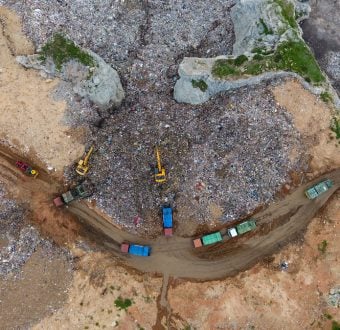Energy Transfer – the company behind the Dakota Access Pipeline – is suing Greenpeace for a cool $300 million USD. You may remember that a similar lawsuit asserting federal racketeering and state tort claims was dismissed by a federal court back in 2019 [1], but Energy Transfer immediately re-filed a virtually identical suit in North Dakota state court [2].
That second lawsuit is still happening and is scheduled to go to trial this summer in North Dakota.
Not only is this a dangerous Strategic Lawsuits Against Public Participation (SLAPP) suit that threatens to undermine our right to protest and speak out against powerful corporations, the arguments being made by Energy Transfer are nonsense.
Here are six things you should know:
1: The lawsuits try to erase the Indigenous leadership of the Standing Rock protests.
The central argument of Energy Transfer’s lawsuits is that Greenpeace – and not the Standing Rock Sioux Tribe or Indigenous water protectors – was the organizer behind the protests at Standing Rock that captured global attention in 2016 and 2017. This is both laughably false and deeply racist.
Energy Transfer’s initial complaint condescendingly described the Standing Rock Sioux Tribe as “impoverished” [3] and alleges that they were “exploited” [4] by outsiders. In the current lawsuit, they argue that the presence of thousands of protesters at Standing Rock was due not to the hard work of the organizers or the moral clarity of their message, but was merely “incit[ed]” [5] by a deliberate “misinformation campaign.” [6]
The truth is that one of the most powerful protest movements in recent history was convened and organized by Native activists living on the frontlines of fossil fuel expansion and facing centuries of government policies that appropriated Native lands and tried to erase Native culture. Well after the camps were established, Greenpeace received a request from the Indigenous community for help sending Indigenous activists to conduct trainings in de-escalation and non-violence. Answering this request, Greenpeace USA supported a delegation from the Indigenous Peoples Power Project (IP3) to travel to Standing Rock and run non-violence trainings. In no way did Greenpeace direct the Standing Rock protest movement.

Rewriting history to erase Indigenous communities and leadership is an ugly old story that is being given a new spin for the era of SLAPPs.
2: The lawsuits invent a fictional “criminal enterprise” that they claim directed the protests.
Energy Transfer’s initial 2017 federal lawsuit tried to concoct a sprawling “criminal enterprise” that directed the pipeline protests with Greenpeace at its center [1]. The initial complaint reads like polluter fanfiction, throwing around wild unsubstantiated claims and drawing far-fetched connections between nearly any group that ever criticized DAPL.
The complaint attempts to tie everything together under the RICO statute – a law designed to target the mafia – that would open the door to punitive damages. Thankfully, a federal judge rejected these flimsy arguments and dismissed the federal racketeering claim in 2019. But the judge never ruled on the state tort claims, and many of these same bad arguments reared their head again when Energy Transfer refiled the suit in North Dakota state court.
3: The lawsuits directly attack legitimate First Amendment-protected speech.
At issue in the North Dakota case are nine statements made by Greenpeace that are alleged to be defamatory. All of the statements at issue are legitimate expressions of the First Amendment protected right to speak.
But even more absurdly, none of the statements at question were original to Greenpeace. Three of these statements were taken from two letters written by another group, one of which was signed by over 500 other organizations (including Greenpeace). In every case, the allegedly defamatory statements had been widely circulated in the media and online for months previously.
The statements in question touch on matters of pressing public importance, and the public’s right to speak out on these topics must not be trampled or curtailed – even when deep-pocketed corporations find that speech inconvenient.
4: The lawsuits directly attack statements of solidarity with the Standing Rock Sioux.
What’s more, in several of these statements, Greenpeace was simply reporting on or repeating claims made explicitly by Standing Rock Sioux Tribal leaders about issues of deep importance to them. In making these statements, Greenpeace was acting in solidarity with the Standing Rock Sioux and the other Tribal Nations challenging the pipeline.
By attacking these statements of support, the lawsuit seeks to shatter the networks and mutual support that make our social movements powerful.
5: The lawsuits try to impose collective liability for anything that happens at protests.
Greenpeace was not an organizer of the Standing Rock protests and did not direct any of the activities that took place there. As requested by protest leaders, Greenpeace supported Indigenous activists who conducted trainings in de-escalation and non-violence. At no time did Greenpeace engage in property destruction or violence. Nonetheless, the lawsuit attempts to connect Greenpeace to all manner of activities that Energy Transfer alleges were done by others.
A similar case attempting to link the organizers of a Black Lives Matter protest to violent action by one person is still ongoing. This lawsuit represents an attempt to expand this bad legal precedent even further, such that anyone who attends a protest–even those who, like Greenpeace, did not organize it–could be held liable for anything that occurred at the protest.
You don’t need a lot of imagination to see that a standard of “collective liability” could be badly abused, and would have a profound chilling effect on protected First Amendment activities. A bad precedent here would be a direct threat to the long tradition of peaceful protest in the United States.
6: Energy Transfer itself has been accused and convicted of numerous crimes and violations.
Around the same time that Energy Transfer filed suit against Greenpeace over First Amendment-protected speech, the company experienced a number of mishaps related to its Mariner and Rover pipelines in Pennsylvania and Ohio. These incidents led to Energy Transfer being convicted of criminal charges in Pennsylvania in 2022, and to two investigations by FERC that are still pending, but which could lead to tens of millions in civil penalties.
Corporations like Energy Transfer hope their legal attacks will silence critics and weaken the movement for justice, for clean air and water, and for a living Earth. We invite you to show them how wrong they are. Spread the word and join the chorus of voices to demonstrate that an attack on one LEADS to a RESPONSE BY ALL.
Citations:
[1] Energy Transfer Equity, L.P. v. Greenpeace International (2017 case). Link to full complaint.
[2] Energy Transfer LP v. Greenpeace International (2019 case). Link to full complaint.
[3] 2017 complaint, p. 6. “The Enterprise exploited the impoverished Tribe’s cause for its own end.”
[4] 2017 complaint, p. 137. “In the final analysis the Enterprise, exploited the Native American tribes, permitting the protestors it purposefully incited to destroy the very lands the Native Americans hold sacred.”
[5] 2019 complaint, p. 10. “First, the Greenpeace Defendants and Banktrack disseminated false statements […] inciting thousands of protestors to descend on Lake Oahe to halt construction of DAPL.”
[6] 2019 complaint, p. 17. “In or around August 2016, in response to the Defendants’ misinformation campaign, thousands of protestors from around the country and the world traveled to North Dakota to join what to date had been small, local protests against DAPL.”



